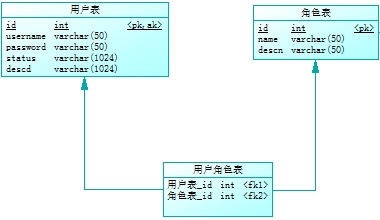Spring Security使用数据库中的用户进行身份认证
来源:互联网 发布:92式步战车模型数据 编辑:程序博客网 时间:2024/06/05 03:46
<dependency> <groupId>mysql</groupId> <artifactId>mysql-connector-java</artifactId> <version>5.1.21</version> </dependency><dependency> <groupId>c3p0</groupId> <artifactId>c3p0</artifactId> <version>0.9.1.2</version> </dependency>
/*Navicat MySQL Data Transfer Source Server : 10.0.0.12Source Server Version : 50619Source Host : 10.0.0.12:3305Source Database : favsecurity Target Server Type : MYSQLTarget Server Version : 50619File Encoding : 65001 Date: 2015-01-23 10:28:39*/ SET FOREIGN_KEY_CHECKS=0; -- ------------------------------ Table structure for role-- ----------------------------DROP TABLE IF EXISTS `role`;CREATE TABLE `role` ( `id` int(11) NOT NULL DEFAULT '0' COMMENT 'id', `name` varchar(50) DEFAULT NULL COMMENT 'name', `descn` varchar(50) DEFAULT NULL COMMENT 'descn', PRIMARY KEY (`id`)) ENGINE=InnoDB DEFAULT CHARSET=utf8 COMMENT='角色表'; -- ------------------------------ Records of role-- ----------------------------INSERT INTO `role` VALUES ('1', 'ROLE_ADMIN', '管理员角色');INSERT INTO `role` VALUES ('2', 'ROLE_USER', '用户角色'); -- ------------------------------ Table structure for user-- ----------------------------DROP TABLE IF EXISTS `user`;CREATE TABLE `user` ( `id` int(11) NOT NULL DEFAULT '0' COMMENT 'id', `username` varchar(50) DEFAULT NULL COMMENT 'username', `password` varchar(50) DEFAULT NULL COMMENT 'password', `status` varchar(1024) DEFAULT NULL COMMENT 'status', `descn` varchar(1024) DEFAULT NULL COMMENT 'descd', PRIMARY KEY (`id`), KEY `AK_Key_1` (`id`)) ENGINE=InnoDB DEFAULT CHARSET=utf8 COMMENT='用户表'; -- ------------------------------ Records of user-- ----------------------------INSERT INTO `user` VALUES ('1', 'admin', 'admin', '1', '管理\r\n员');INSERT INTO `user` VALUES ('2', 'user', 'user', '1', '用户\r\n');INSERT INTO `user` VALUES ('3', 'favccxx', 'favboy', '1', '帅锅'); -- ------------------------------ Table structure for user_role-- ----------------------------DROP TABLE IF EXISTS `user_role`;CREATE TABLE `user_role` ( `user_id` int(11) DEFAULT NULL COMMENT '用户表_id', `role_id` int(11) DEFAULT NULL COMMENT '角色表_id', KEY `FK_FK_USER_ROLE_ROLE` (`role_id`), KEY `FK_FK_USER_ROLE_USER` (`user_id`), CONSTRAINT `FK_FK_USER_ROLE_USER` FOREIGN KEY (`user_id`) REFERENCES `user` (`id`), CONSTRAINT `FK_FK_USER_ROLE_ROLE` FOREIGN KEY (`role_id`) REFERENCES `role` (`id`)) ENGINE=InnoDB DEFAULT CHARSET=utf8 COMMENT='用户角色表'; -- ------------------------------ Records of user_role-- ----------------------------INSERT INTO `user_role` VALUES ('1', '1');INSERT INTO `user_role` VALUES ('1', '2');INSERT INTO `user_role` VALUES ('2', '2');INSERT INTO `user_role` VALUES ('3', '1');INSERT INTO `user_role` VALUES ('3', '2');<?xml version="1.0" encoding="UTF-8"?><beans xmlns="http://www.springframework.org/schema/beans" xmlns:xsi="http://www.w3.org/2001/XMLSchema-instance" xmlns:context="http://www.springframework.org/schema/context" xmlns:tx="http://www.springframework.org/schema/tx" xmlns:aop="http://www.springframework.org/schema/aop" xsi:schemaLocation="http://www.springframework.org/schema/beans http://www.springframework.org/schema/beans/spring-beans-3.0.xsd http://www.springframework.org/schema/context http://www.springframework.org/schema/context/spring-context-3.0.xsd http://www.springframework.org/schema/tx http://www.springframework.org/schema/tx/spring-tx-3.0.xsd http://www.springframework.org/schema/aop http://www.springframework.org/schema/aop/spring-aop-3.0.xsd "> <context:property-placeholder location="classpath:database.properties"/> <bean id="dataSource" class="com.mchange.v2.c3p0.ComboPooledDataSource" destroy-method="close"> <property name="driverClass"> <value>${dataSource.driverClassName}</value> </property> <property name="jdbcUrl"> <value>${dataSource.url}</value> </property> <property name="user"> <value>${dataSource.username}</value> </property> <property name="password"> <value>${dataSource.password}</value> </property> <!-- 最大连接数 --> <property name="maxPoolSize"> <value>${dataSource.c3p0.max_size}</value> </property> <!-- 最小连接数 --> <property name="minPoolSize"> <value>${dataSource.c3p0.min_size}</value> </property> <!-- 最大空闲时间,超时未被使用则连接被抛弃,单位毫秒 --> <property name="maxIdleTime"> <value>${dataSource.c3p0.max_idle_time}</value> </property> <!-- 获得连接的超时时间,如果超过这个时间,会抛出异常,单位毫秒 --> <!-- <property name="checkoutTimeout"> <value>${dataSource.c3p0.checkout_timeout}</value> </property> --> <!-- 最大的PreparedStatement的数量 --> <property name="maxStatements"> <value>${dataSource.c3p0.max_statements}</value> </property> <!-- 每隔120秒检查连接池里的空闲连接 ,单位是秒 --> <property name="idleConnectionTestPeriod"> <value>${dataSource.c3p0.idle_test_period}</value> </property> <!-- 当连接池里面的连接用完的时候,C3P0一下获取的新的连接数 --> <property name="acquireIncrement"> <value>${dataSource.c3p0.acquire_increment}</value> </property> </bean> </beans><![CDATA[dataSource.driverClassName=com.mysql.jdbc.DriverdataSource.username=favccxxdataSource.password=favboydataSource.url=jdbc:mysql://10.0.0.12:3305/favsecurity?useUnicode=true&characterEncoding=utf-8 # For c3p0 connect pooldataSource.c3p0.max_size=200dataSource.c3p0.min_size=10dataSource.c3p0.max_idle_time=300#dataSource.c3p0.checkout_timeout=30000dataSource.c3p0.max_statements=0dataSource.c3p0.idle_test_period=120dataSource.c3p0.acquire_increment=5 ]]>
0 0
- Spring Security使用数据库中的用户进行身份认证
- 基于spring security的简易用户身份认证(数据库)
- Spring Security笔记:使用数据库进行用户认证(form login using database)
- 使用PHP进行用户身份认证
- Spring Security 实现身份认证
- Spring Security身份认证之HelloSpringSecurity
- Spring Security身份认证之UserDetailsService
- spring security起步六:基于数据库的用户认证
- 使用WS-Security框架对信息进行加密与身份认证
- 用户身份认证(Authenticate),并将用户输入的信息与数据库进行判断
- angularjs route 中的用户身份认证
- 使用Apache Shiro进行身份认证
- [ZT]使用 PAM 进行身份认证
- express,使用session进行身份认证
- 使用Apache Shiro进行身份认证-LDAP认证
- 使用Apache Shiro进行身份认证-LDAP两次绑定认证
- 使用Apache Shiro进行身份认证-Active Directory认证
- 使用Apache Shiro进行身份认证-多数据源认证
- 队列的链表表示
- hdoj 1010 Tempter of the Bone 【dfs+奇偶剪枝】
- 普元7.2发布WebService
- DataGridView中comboBox数据绑定的问题
- MTK android系统源码修改快速上手
- Spring Security使用数据库中的用户进行身份认证
- 常用 iOS各种问题
- Tomcat配置文件入门
- Nginx的TCP负载均衡介绍
- 发发牢骚
- MyEclipse 安装Spket (支持Extjs4.1.1及jQuery1.8)
- Android锁屏修改
- 比较常用的sql语句
- 第八周 课后实践:项目二——Time类中的运算符重载





